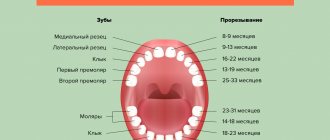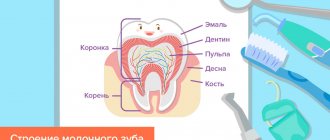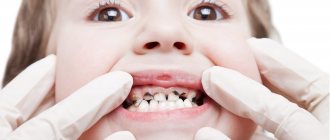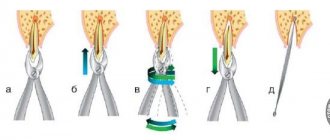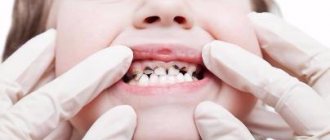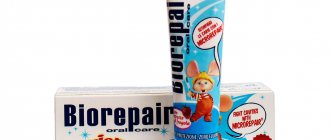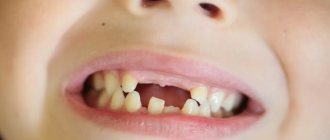From this article you will learn:
- how many baby teeth does a person have,
- How are temporary teeth different from permanent teeth?
- Scheme of loss of baby teeth in children.
Milk teeth are a set of twenty temporary teeth that begin to erupt in a child, usually at the age of 5-6 months (the central incisors of the lower jaw erupt first). The need for temporary teeth is evolutionarily determined by the small size of the jaws of newborns. Permanent teeth are much larger than milk teeth, and their number is 1.5 times greater, and therefore, if children immediately had permanent teeth, they simply would not be able to fit into small jaws.
Because of this, in small jaws, smaller temporary teeth (in a reduced number) erupt first, and only when the jaws reach the desired size does the child replace milk teeth with permanent ones. Therefore, the time when baby teeth fall out in children is integrally connected with the growth of the jaw bones and the development of the rudiments of permanent teeth. Typically, the loss of primary teeth begins in children at the age of 6 years, and in girls this process begins earlier and proceeds faster.
In Fig. 2 you can see how the change of baby teeth to permanent ones in children looks like on an x-ray. In this case, we see that the child has already erupted permanent central and lateral incisors, as well as the first permanent molars. But in the lateral sections of the jaws we also see still preserved milk teeth, between the roots of which the rudiments of permanent teeth are located.
Approximate timing of baby teeth eruption
On average, the first tooth appears at 6-7 months, but sometimes this joyful event occurs earlier - at 4-5 months, or, on the contrary, is delayed. The reason for this, as a rule, is heredity. Therefore, you should not unconditionally rely on generally accepted charts: everything is individual.
In general, the monthly scheme looks like this:
- 6-7 months - most babies have 2 lower incisors in the center;
- 8-9 months – by this age you can expect 2 upper incisors;
- 9-11 months – by almost a year, 2 lateral incisors are visible from above;
- 12-13 months - during this period there are also 2 lateral incisors from below.
So, to the question of how many baby teeth a child should have by the age of one year, we can safely answer: 8.
Names of teeth, their types
Incisors, canines, premolars and molars make up the dental arch. To make it easier to remember, the teeth were numbered from 1 to 8:
- 1 and 2 - incisors;
- 3 - fangs;
- 4 and 5 - premolars;
- 6, 7, 8 - molars.
Having examined and delved into the numbering and names, you understand what kind of teeth a person has. But each tooth has its own specific functions and is responsible for certain processes during eating.
For example, the incisors give a person the ability to bite off pieces of food; fangs help capture food; premolars and molars help grind food and make our cheekbones more aesthetic, as they have an angular position.
After a year, teeth appear with the following frequency:
- by 12-15 months – two pairs of first molars erupt;
- by 18-20 months – a pair of upper and a pair of lower canines are already clearly visible;
- 20-30 months is the period of appearance of two pairs of second molars.
How many teeth should a child have at 1 year 3 months? Ideally 12, but the number can change in one direction or the other, and this is not considered a deviation. The frequency of teething is influenced by many factors, including previous infections, heredity, climate, and health status.
The question of how many teeth a child should have at 1 year 8 months, or 20 months, also cannot be answered unambiguously. The answer will be approximate - about 16. Up to a year, parents should focus on the approximate formula: the number of months minus 4, with a reservation for the baby’s characteristics.
What are the features of the eruption of “temporary” teeth?
Baby teething normally occurs at six months of age. The first sign of this process is the formation of a dental tubercle on the edge of the gum. This occurs as a result of pressure on the mucous membrane - it gradually stretches, becomes thinner and a breakthrough occurs. Then you can see the edge of the crown of the new tooth above the gum. As soon as the entire crown appears above the gum cavity, this is the eruption of the tooth.
In various sources you can find exact dates for teething, but they are arbitrary. Any discrepancies with them depend on the individual developmental characteristics of the baby. There is no need to worry if your child's first tooth appears later or earlier than his peers. Teething is a natural process that occurs on an individual schedule.
Did you know that baby teeth have roots? It’s just that by the time they begin to fall out, they resolve on their own. If sometimes a tooth has to be removed before its natural loss occurs, its root can be seen.
In erupted baby teeth, the formation of roots occurs according to the following scheme:
- The formation of the roots of the incisors occurs by the age of two.
- The roots of the molars will be fully formed by the age of 4 years.
- The formation of the roots of the fangs occurs by the age of 5 years.
How many teeth should a child have at 3 years old?
All twenty baby teeth appear by about 2-2.5 years. It includes eight incisors and molars, as well as four canines. By this time, they are erupting, including in the wrong direction, but by the age of three, in most cases they occupy a normal position, since the child is actively chewing food.
If by the age of three a boy or girl does not have a full set, do not panic. This may be an individual characteristic of the child. To be sure, it is advisable to consult a pediatrician and dentist to clarify the cause of the delay and rule out rickets, metabolic disorders or endocrine diseases.
Scheme - schedule for changing teeth in children:
- The central incisors are subject to renewal at the age of about 5 or 7 years, soon followed by the lateral ones.
- From 9 to 11 years the first molars are expected.
- At the same time as the molars, the canines also change.
- In the period of 10-13 years, the second molars also emerge.
By the age of 13, a teenager’s mouth can already count about 28 teeth. If there is a one-year delay in their appearance, it is recommended to consult a dentist. An adult must have at least 28 or 32 teeth. It must be remembered that from the age of five there begins a period of replacement of milk teeth with those that will be with a person throughout his life.
First signs of teething
You can recognize the imminent appearance of a tooth in a baby by the following external signs and changes in behavior:
- Crawling babies put their fingers and everything they see into their mouths. Their gums itch.
- Saliva floods my blouse and prevents me from sleeping at night.
- Sleep and appetite are disturbed.
- The gums swell and turn red.
- A couple of days before teething, a runny nose appears and sometimes a cough.
- The stool becomes liquid, mushy with a yellow, green tint.
- The temperature rises within acceptable limits.
- Whims, tears, crying are suddenly replaced by laughter and good mood. The child does not know what he wants, often asks to be held, and worries without his parents.
A baby, even at one or one and a half years old, experiences stress. Mothers need to understand and forgive the baby for his whims and disturbing dreams. Try to help during this difficult period for everyone. Do not get angry or yell at your daughter or son under any circumstances. Newborns do not yet know how to patiently endure toothache and discomfort and require the attention and care of their parents.
Should I contact a pediatric dentist?
If a child’s teeth grow without pain or inflammation, it is enough to go for regular preventive examinations every six months.
You need to make an appointment at the dental clinic when:
- molars do not grow longer than 5 months. You may need orthodontic treatment to correct your bite.
- the indigenous ones began to grow, but the dairy ones still remained. To form a correct bite, temporary teeth must be removed.
- a baby tooth fell out due to injury. Neighboring teeth can take up empty space and the molar has nowhere to grow.
- The child grinds his teeth a lot at night. Because of this, the enamel is damaged, so the dentist prescribes special mouth guards that are put on the teeth before going to bed.
- Be sure to consult a doctor at the first signs of caries. The process quickly goes deep into the baby tooth, and can move on to the rudiments of the molars.
Remember: timely prevention of oral diseases means correct bite and a beautiful smile. Therefore, you need to take care of your teeth from childhood.
What microelements are needed for teeth growth?
Vitamins and microelements are a necessary component for the development and normal functioning of the child and adult body. The formation of dental tissue cannot do without:
Fluorine
Strengthens enamel, makes incisors resistant to bacteria, the destructive effects of acids, and prevents caries. Fluoride is taken in tablets or drops when a deficiency is diagnosed. Enters the body with sea fish, nuts, grape juice, spinach, and most vegetables.
Toothpastes with fluoride are not approved for use by children under 4–5 years of age. Children aged 1.5–3 years swallow the tasty mass when cleaning their mouths, and an excess of the element is formed in the blood. For foolish children, choose toothpastes without fluoride to protect them from the negative consequences of hygiene procedures.
Calcium
It is the building material of infants' teeth. Without calcium, mineralization in tissues is impossible. After finishing breastfeeding, a one-year-old child should receive dairy products daily, greens and fish at least three times a week.
Vitamin K
Necessary for complete absorption of calcium and protein synthesis. Found only in natural dairy products (cottage cheese, sour cream and others).
Teething for young parents seems like an extremely difficult and nervous process. They prepare for it mentally, they are afraid of hysterics and hyperthermia.
Young and inexperienced parents do not need to worry or be negative. It is better to study the issue of dentition in infancy in order to arm yourself with knowledge and understand why the baby cries and is nervous. In this case, jaw development will be perceived as a normal physiological stage of growth, which will be experienced easily and quickly.
Time of start of eruption
The appearance of the first tooth is a holiday for the whole family, but only a loving mother and an attentive father know how much anxiety and worries are associated with this event. A couple of days, or even weeks, before the first external signs of teething appear, children cry, are capricious, and lose their appetite. Moms are having a hard time—sleepless nights.
The central tooth below can grow even at eleven months. The timing of teething is individual for each baby. For almost all babies, only the symptoms of a tooth appearing remain the same. And even a professional doctor cannot determine exactly how many months the process of jaw formation will begin.
Teeth of 4 year old children. The importance of caring for baby teeth
How many teeth should a child have at 4 years old? By the age of 4, almost all children have a full set of baby teeth - 20 pieces (maybe only 16 - this is individual, and this is the norm). The child actively uses them - bites, chews. That is, teeth are constantly in an aggressive environment and are subject to mechanical stress, including abrasion. In the article “Baby teeth in children - norm, features, purpose,” we talked in detail about the structure of children’s teeth.
In particular, the fact that the enamel coating of baby teeth is much thinner than that of permanent teeth, that it is more permeable, and the pulp occupies most of the volume of the tooth. For this reason, the first teeth are more susceptible to caries, and carious cavities reach the pulp faster. In an adult, before the onset of inflammation of the pulp - pulpitis, caries develops for a year, or even several years. Six months or a little more is enough for children's teeth. Especially if the child does not receive adequate nutrition or has a metabolic disorder. This is where caring for baby teeth comes to the fore.
Treatment and care of baby teeth
Many parents have a big misconception - baby teeth are temporary, which means it is not necessary to take care of them, there is no need to treat them, they say, they will fall out anyway. This is fundamentally wrong - a baby’s teeth are vitally important, and that’s exactly what they are at this time. This is how a child’s body works. And the absence or inadequate functioning of baby teeth can lead to irreparable losses in later life. Untreated baby teeth can lead to both local problems, the most difficult of which is damage or even dissolution of the permanent tooth germ, and general problems: diseases of the gastrointestinal tract, problems with the adenoids, chronic runny nose and tonsillitis, etc. Treatment Primary teeth treatment in children is no less important than the treatment of permanent teeth. Untimely removal of a baby tooth leads to the shifting of other teeth, which means abnormal development of the jaw. The location of the rudiments of permanent teeth automatically shifts, which will grow very closely in one place, and in others there will be large, unaesthetic gaps.
The earlier the baby loses a baby tooth, the more noticeable the consequences will be. For example, if a child soon loses chewing teeth (before 5-6 years), then the correct growth of the jaws is disrupted, and even facial features change, especially in the lower part. If caries of baby teeth has begun, timely treatment is the most important factor in the full development of permanent teeth (“What is the danger of premature removal of baby teeth”). Sucking on a pacifier, feeding from a bottle, and even breastfeeding after the age of 2 years also have a very unfavorable effect on baby teeth. It is for this reason that we constantly draw the attention of adults - take care of your children’s early teeth, because this is their ticket to a healthy, fulfilling life.
Permissible deviations from the schedule
Signs of the imminent appearance of the first teeth are drooling, swollen gums, and fever. It is important to monitor the child’s well-being during this period.
READ ALSO: How can you lower your temperature if you are teething?
As noted above, at six months the baby already has his first teeth. A shift of one to three months later than normal indicates rickets or an infectious disease. Also the cause is illnesses that the woman suffered during the period of gestation.
On the contrary, the early appearance of teeth is a symptom of unstable functioning of the endocrine system. The absence of teeth up to a year is rarely associated with edentia, that is, with the absence of rudiments. This can be checked in the pediatric dentist's office.
Memo to parents
☑️ An empty hole should not bleed much. If the capillaries are damaged, it is enough to apply a sterile swab until the bleeding stops. Set aside lunch for 1-2 hours. You can drink unsweetened liquids, preferably water.
☑️ There is no need to smear the wound with antiseptics or rinse your mouth - the blood clot covering the hole will be washed away.
☑️ The bleeding does not stop for more than 10 minutes - consult a doctor.
☑️ To strengthen the roots of new teeth, you need to load your jaws. Give your child more fruits and vegetables to chew on: apples, young carrots.
☑️ Calcium is necessary for growing teeth. Dairy products are rich in it, especially hard cheese, cottage cheese and kefir. There is a lot of calcium in greens and legumes; to “get” it from foods, add 10-20 grams of fat to the dish.
Children can have candy! The main rule for preventing caries in children during tooth growth is that there should be no sugar or food particles left in the mouth.
Candy is tasty and safe if you brush your teeth or rinse your mouth with clean water after dessert.
